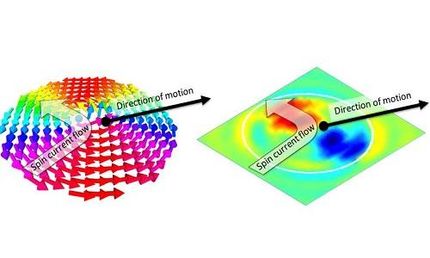Taking magnetism for a spin
Exploring the mysteries of skyrmions
Scientists at the U.S. Department of Energy's Ames Laboratory have discovered the relaxation dynamics of a zero-field state in skyrmions, a spinning magnetic phenomenon that has potential applications in data storage and spintronic devices.

Skyrmions are nanoscale whirls or vortices of magnetic poles that form lattices within a magnetic material, a type of quasiparticle that can zip across the material, pushed by electrical current.
Ames Laboratory, US Department of Energy
Skyrmions are nanoscale whirls or vortices of magnetic poles that form lattices within a magnetic material, a type of quasiparticle that can zip across the material, pushed by electrical current. Those properties have captured the fascination of scientists, who think the phenomenon could lead to the next big advance in data storage, making digital technology even faster and smaller.
There are some big challenges to overcome, however. Until recently skyrmions were a phenomenon only observed at extreme low temperature. Also, external magnetic forces makes them currently impractical for applications.
"In order to be really useful in a device, these magnetic vortices need to be able to exist without the 'help' of an external magnetic field," said Lin Zhou, a scientist in the Ames Laboratory's Division of Materials Sciences and Engineering.
With that in mind, she and other researchers at Ames Laboratory investigated FeGe, an iron-germanium magnetic material that has demonstrated skyrmions in the highest temperature ranges to date in crystals with a similar, or B20 structure.
Ames Lab scientists with external collaborators were able to establish a skyrmion lattice in a sample through exposure to magnetic fields and supercooling with liquid nitrogen. With a high resolution microscopy method called Lorentz transmission electron microscopy (L-TEM), the team was able to observe the skyrmion lattice in zero magnetic field, and then observe the decay of the skyrmions as the temperature warmed. This direct observation yielded critical new information about how skyrmions behave and how they revert back to a 'normal' (what scientists call metastable) magnetic state.
"We've stabilized these skyrmions without a magnetic field, and our microscopy techniques allowed us to really see how the vortices change over time, temperature, and magnetic field; we think it provides a very solid foundation for theorists to better understand this phenomenon," Zhou said.
Original publication
Licong Peng, Ying Zhang, Liqin Ke, Tae-Hoon Kim, Qiang Zheng, Jiaqiang Yan, X.-G. Zhang, Yang Gao, Shouguo Wang, Jianwang Cai, Baogen Shen, Robert J. McQueeney, Adam Kaminski, Matthew J. Kramer, and Lin Zhou; "Relaxation Dynamics of Zero-Field Skyrmions over a Wide Temperature Range"; Nano Letters; 2018
Most read news
Original publication
Licong Peng, Ying Zhang, Liqin Ke, Tae-Hoon Kim, Qiang Zheng, Jiaqiang Yan, X.-G. Zhang, Yang Gao, Shouguo Wang, Jianwang Cai, Baogen Shen, Robert J. McQueeney, Adam Kaminski, Matthew J. Kramer, and Lin Zhou; "Relaxation Dynamics of Zero-Field Skyrmions over a Wide Temperature Range"; Nano Letters; 2018
Topics
Organizations
Other news from the department science

Get the chemical industry in your inbox
By submitting this form you agree that LUMITOS AG will send you the newsletter(s) selected above by email. Your data will not be passed on to third parties. Your data will be stored and processed in accordance with our data protection regulations. LUMITOS may contact you by email for the purpose of advertising or market and opinion surveys. You can revoke your consent at any time without giving reasons to LUMITOS AG, Ernst-Augustin-Str. 2, 12489 Berlin, Germany or by e-mail at revoke@lumitos.com with effect for the future. In addition, each email contains a link to unsubscribe from the corresponding newsletter.




























































